City Contours Schwäbisch Hall
Probably the smallest cosmopolitan city in the world
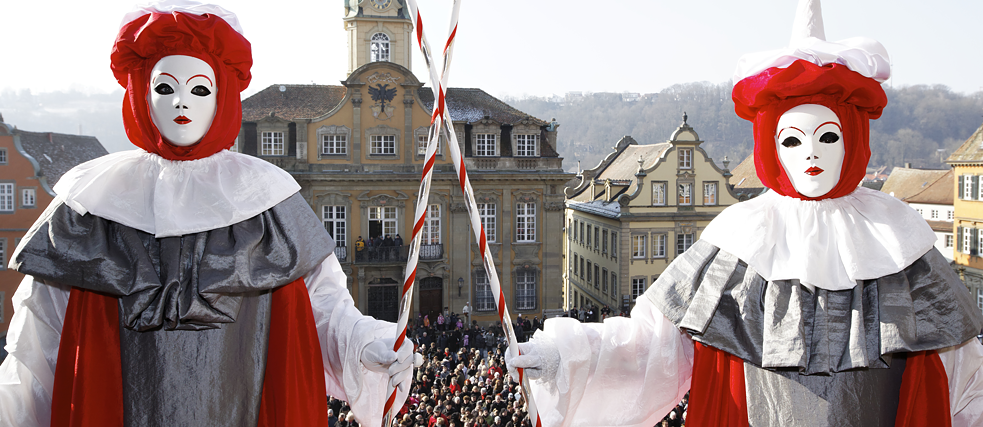
Anyone who thinks all small towns are sleepy and quiet is quite wrong, or at least wrong about Schwäbisch Hall. It is home to world-class art and theatre and some world market leaders, all conveniently within walking distance.
By Tatjana Kruse
The pulsating heart of the city – a marketplace and a feast for the eyes in one
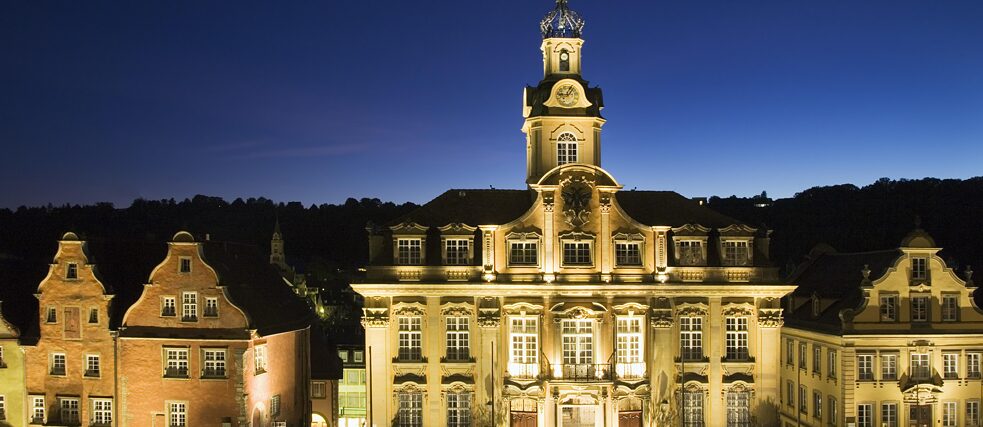 The Town Hall on Schwäbisch Hall’s marketplace.
| Photo (detail): © picture alliance / Markus Lange / imageBROKER
Those who live there lovingly call Schwäbisch Hall just Hall, since although the city was annexed by the Duke of Württemberg in 1802, those once loyal to the house of Hohenlohe do not consider themselves Swabians. If you ask locals, they are confident that Hall has the most beautiful marketplace in all of Germany. For over 800 years, the Protestant Church of St. Michael has dominated the space where the Middle Ages quite literally runs up against the Baroque. This is where the great fire of 1728 ended and any medieval buildings that did not survive were rebuilt in the baroque style, gorgeous, elaborate constructions that happily survived the Second World War. The Church of St. Michael with its 53 steps (or is it 54? probably best to count them yourself) and tower just under 47 metres tall is the city’s landmark, right behind the four bricks in the Schwäbisch Hall building society’s logo. Anyone who took the time to lean up against the walls of the town hall and hang about for long enough would eventually see every Haller go by, maybe buying vegetables at the Saturday market, drinking mulled wine at the picturesque Christmas market, crossing the finish line in the town race – the Three Kings Run, at the huge Cake and Fountain Festival at Whitsuntide, enjoying the open-air theatre in the summer or at the multi-cultural Day of Friendship in autumn. The marketplace is the pulsating heart of the city.
The Town Hall on Schwäbisch Hall’s marketplace.
| Photo (detail): © picture alliance / Markus Lange / imageBROKER
Those who live there lovingly call Schwäbisch Hall just Hall, since although the city was annexed by the Duke of Württemberg in 1802, those once loyal to the house of Hohenlohe do not consider themselves Swabians. If you ask locals, they are confident that Hall has the most beautiful marketplace in all of Germany. For over 800 years, the Protestant Church of St. Michael has dominated the space where the Middle Ages quite literally runs up against the Baroque. This is where the great fire of 1728 ended and any medieval buildings that did not survive were rebuilt in the baroque style, gorgeous, elaborate constructions that happily survived the Second World War. The Church of St. Michael with its 53 steps (or is it 54? probably best to count them yourself) and tower just under 47 metres tall is the city’s landmark, right behind the four bricks in the Schwäbisch Hall building society’s logo. Anyone who took the time to lean up against the walls of the town hall and hang about for long enough would eventually see every Haller go by, maybe buying vegetables at the Saturday market, drinking mulled wine at the picturesque Christmas market, crossing the finish line in the town race – the Three Kings Run, at the huge Cake and Fountain Festival at Whitsuntide, enjoying the open-air theatre in the summer or at the multi-cultural Day of Friendship in autumn. The marketplace is the pulsating heart of the city.
Steps that mean the world to Hall
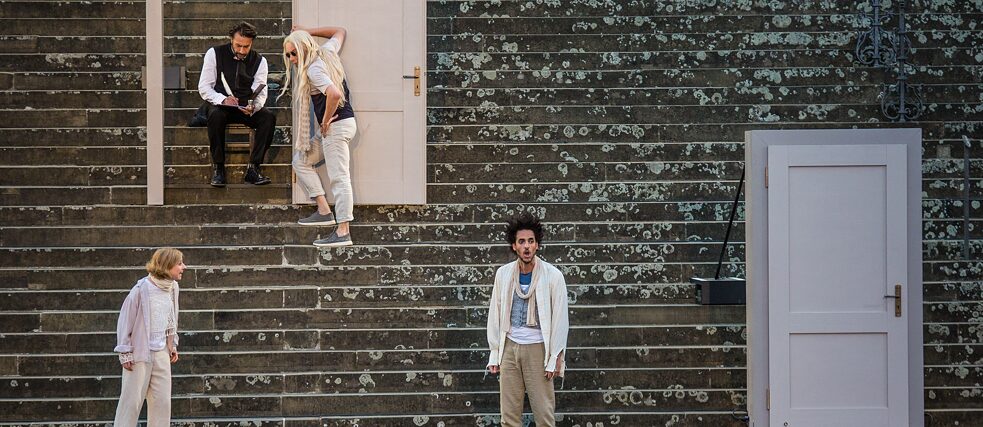 Every year from June to August, the steps of the Church of St Michael become an open-air stage in Schwäbisch Hall. The play “Brenz 1548” by Andreas Gäßler premiered here in 2017.
| Photo (detail): © picture alliance /Christoph Schmidt/dpa
And speaking of the marketplace: the steps to the Church of St. Michael – one of the favourite Instagram themes for tourists right after the city skyline – are the site of the annual Schwäbisch Hall Open Air Theatre Festival. The historic marketplace provides the backdrop for a colourful mix of classics from world literature, musical theatre and the avant-garde. Hall has hosted the festival for almost one hundred years now. Well-known and up-and-coming actors are frequently supported by local extras in enlivening the summer nights with their dramatic skills. It all began in 1925 with Hugo von Hofmannsthal’s Jedermann (Everyman), which has been featured on the program every couple of years ever since. See and be seen is the motto at premieres. And it is worth swinging by the marketplace during rehearsals in the daylight hours to see how theatre magic is made. Winter doesn’t signal the end of the theatre season either, when the New Globe Theatre on an island in River Kocher offers actors indoor boards to tread.
Every year from June to August, the steps of the Church of St Michael become an open-air stage in Schwäbisch Hall. The play “Brenz 1548” by Andreas Gäßler premiered here in 2017.
| Photo (detail): © picture alliance /Christoph Schmidt/dpa
And speaking of the marketplace: the steps to the Church of St. Michael – one of the favourite Instagram themes for tourists right after the city skyline – are the site of the annual Schwäbisch Hall Open Air Theatre Festival. The historic marketplace provides the backdrop for a colourful mix of classics from world literature, musical theatre and the avant-garde. Hall has hosted the festival for almost one hundred years now. Well-known and up-and-coming actors are frequently supported by local extras in enlivening the summer nights with their dramatic skills. It all began in 1925 with Hugo von Hofmannsthal’s Jedermann (Everyman), which has been featured on the program every couple of years ever since. See and be seen is the motto at premieres. And it is worth swinging by the marketplace during rehearsals in the daylight hours to see how theatre magic is made. Winter doesn’t signal the end of the theatre season either, when the New Globe Theatre on an island in River Kocher offers actors indoor boards to tread.
Cultural overload
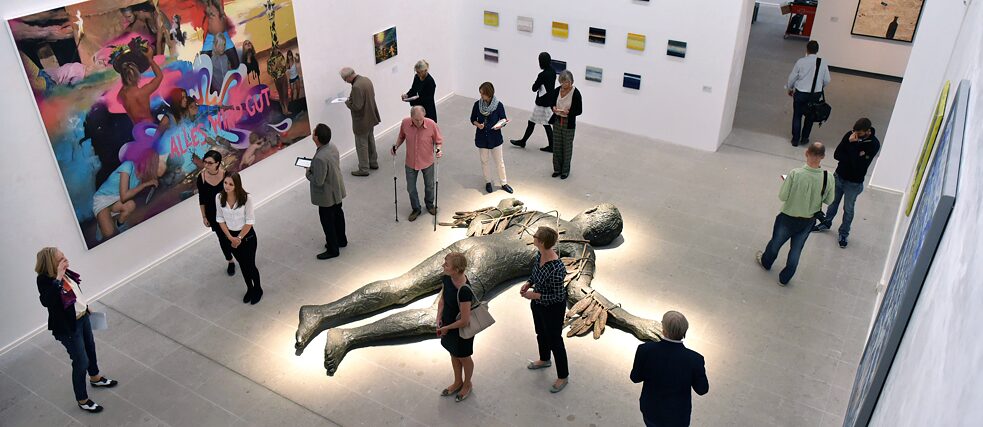 Visitors admire the statue “Icarus” by Stephan Balkenhol in the exhibition “Wasser, Wolken, Wind. Elementar- und Wetterphänomene in Werken der Sammlung Würth. ” (Water, Clouds, Wind. Natural and Weather Occurrences in Works of the Würth Collection.)
| Photo (detail): © picture alliance/Jan-Philipp Strobel/dpa
Screw manufacturer Reinhold Würth, whose company headquarters are roughly 30 kilometres away in the town of Künzelsau, has made a name for himself as a patron of the arts over the past decades. So, the Würth name is well-known among do-it-yourselfers and art lovers alike. Danish architect Hennig Larsen designed the Kunsthalle Würth (Würth Art Museum) to fit seamlessly into the old cityscape. Pieces from Würth’s collections and works on loan from famous museums and collectors make their way to Schwäbisch Hall in changing exhibitions. Just a few metres further along, the former Johanniterkirche (Knight Hospitaler Church) serves as a Kunsthalle Würth annex. There among sacral and worldly medieval art, visitors can admire Hans Holbein the Younger’s Madonna in her protective shell. And the roof of the Sudhaus, a restaurant directly next to the museum, offers the best view of the city and the meandering Kocher.
Visitors admire the statue “Icarus” by Stephan Balkenhol in the exhibition “Wasser, Wolken, Wind. Elementar- und Wetterphänomene in Werken der Sammlung Würth. ” (Water, Clouds, Wind. Natural and Weather Occurrences in Works of the Würth Collection.)
| Photo (detail): © picture alliance/Jan-Philipp Strobel/dpa
Screw manufacturer Reinhold Würth, whose company headquarters are roughly 30 kilometres away in the town of Künzelsau, has made a name for himself as a patron of the arts over the past decades. So, the Würth name is well-known among do-it-yourselfers and art lovers alike. Danish architect Hennig Larsen designed the Kunsthalle Würth (Würth Art Museum) to fit seamlessly into the old cityscape. Pieces from Würth’s collections and works on loan from famous museums and collectors make their way to Schwäbisch Hall in changing exhibitions. Just a few metres further along, the former Johanniterkirche (Knight Hospitaler Church) serves as a Kunsthalle Würth annex. There among sacral and worldly medieval art, visitors can admire Hans Holbein the Younger’s Madonna in her protective shell. And the roof of the Sudhaus, a restaurant directly next to the museum, offers the best view of the city and the meandering Kocher.
Hidden champions
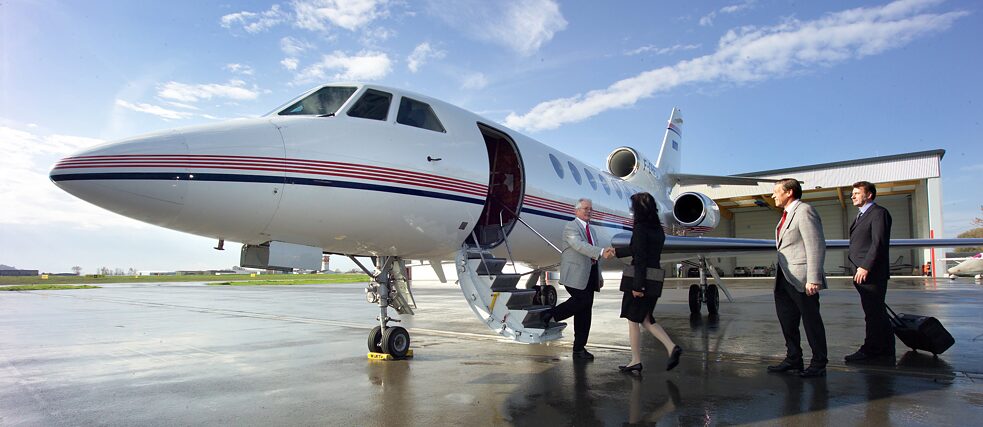 Many companies well-known in their respective branches are headquartered in and around Schwäbisch Hall, such as leaders in ventilator technology, sauna construction, airplane seating, and filling and packaging technology.
| Photo (detail): © Stadt Schwäbisch Hall
When they hear the name Schwäbisch Hall, many immediately think of the eponymous building society headquartered here. The city and the region are full of companies at the forefront of their particular branch worldwide. They dominate in areas like ventilator technology, sauna construction, airplane seating, and filling and packaging technology. This is hardly a well-kept secret, of course, and every year around January and February, a summit meeting of world-market leaders takes place in Schwäbisch Hall. Former Minister of Economic Affairs for the state of Baden-Württemberg, Dr Walter Döring, first came up with the idea of inviting executives and entrepreneurs from around the world to come learn from local companies – the medium-sized and often family-run “hidden champions” of Schwäbisch Hall.
Many companies well-known in their respective branches are headquartered in and around Schwäbisch Hall, such as leaders in ventilator technology, sauna construction, airplane seating, and filling and packaging technology.
| Photo (detail): © Stadt Schwäbisch Hall
When they hear the name Schwäbisch Hall, many immediately think of the eponymous building society headquartered here. The city and the region are full of companies at the forefront of their particular branch worldwide. They dominate in areas like ventilator technology, sauna construction, airplane seating, and filling and packaging technology. This is hardly a well-kept secret, of course, and every year around January and February, a summit meeting of world-market leaders takes place in Schwäbisch Hall. Former Minister of Economic Affairs for the state of Baden-Württemberg, Dr Walter Döring, first came up with the idea of inviting executives and entrepreneurs from around the world to come learn from local companies – the medium-sized and often family-run “hidden champions” of Schwäbisch Hall.
The finest of fields
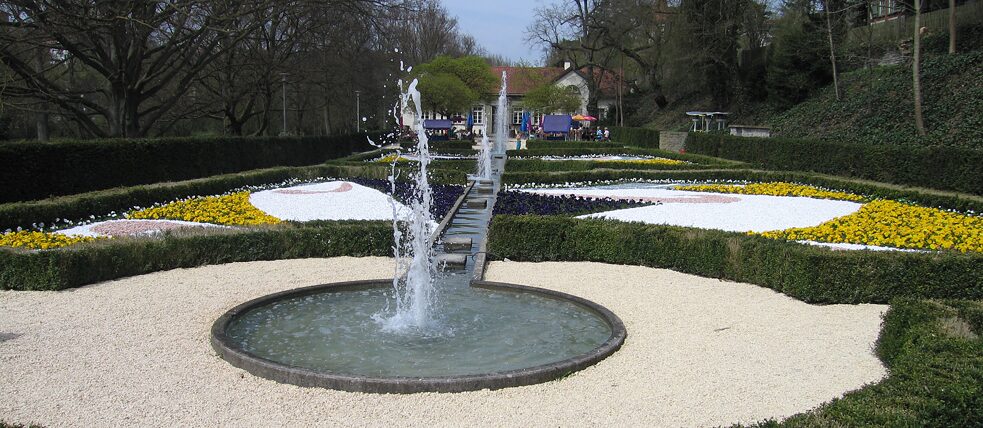 This “field” has more than a little style: fountains and water axis in Hall’s City Park.
| Foto (Detail): © Adobe
Locals playfully call their city park, Schwäbisch Hall’s green lung, “the fields”, since the potatoes that kept people from starving were grown there right after the war. The Landesgartenschau (State Garden Show) in 1982 was a stroke of luck for the recreational area. It was completely redesigned, turning the fields into a park stretching over ten hectares. In summer tourists and locals swarm to its lawns to picknick, relax in the grass, practice Capoeira among the trees or give the dog a good airing out. For the Summer Night Festival in August, the park is transformed into a sea of thousands of tealights and paper lanterns.
This “field” has more than a little style: fountains and water axis in Hall’s City Park.
| Foto (Detail): © Adobe
Locals playfully call their city park, Schwäbisch Hall’s green lung, “the fields”, since the potatoes that kept people from starving were grown there right after the war. The Landesgartenschau (State Garden Show) in 1982 was a stroke of luck for the recreational area. It was completely redesigned, turning the fields into a park stretching over ten hectares. In summer tourists and locals swarm to its lawns to picknick, relax in the grass, practice Capoeira among the trees or give the dog a good airing out. For the Summer Night Festival in August, the park is transformed into a sea of thousands of tealights and paper lanterns.
The giant in the sea of houses
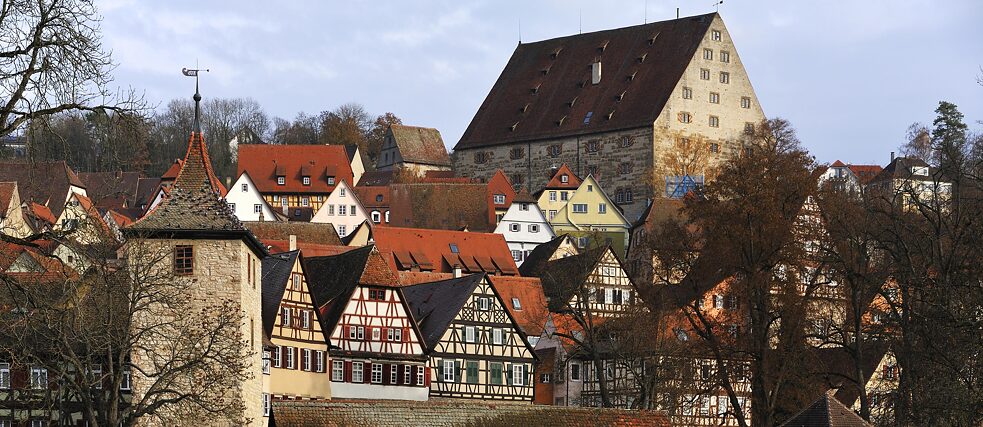 The former storehouse Zehntscheuer, a very prominent part of the cityscape, is an event venue today.
| Photo (detail): © picture alliance /Helmut Meyer zur Capellen/imageBROKER
Built in the 16th century, the Zehntscheuer (literally “tithe barn”), once the storehouse for the free, imperial city, is impossible to overlook. The imposing size of the former granary is an indication of how wealthy Hall became from the saline springs and salt trade. No wheat has seen the inside of the building for ages though, and today artists of all persuasions – cabaretists, classic orchestras, ballet ensembles and even Shaolin monks – pursue their craft in the Neubausaal (New Hall).
The former storehouse Zehntscheuer, a very prominent part of the cityscape, is an event venue today.
| Photo (detail): © picture alliance /Helmut Meyer zur Capellen/imageBROKER
Built in the 16th century, the Zehntscheuer (literally “tithe barn”), once the storehouse for the free, imperial city, is impossible to overlook. The imposing size of the former granary is an indication of how wealthy Hall became from the saline springs and salt trade. No wheat has seen the inside of the building for ages though, and today artists of all persuasions – cabaretists, classic orchestras, ballet ensembles and even Shaolin monks – pursue their craft in the Neubausaal (New Hall).
Make hay while the sun shines
 While other cities celebrate Carnival or Fasching, the residents of Hall get decked out in fantastic costumes to parade through the streets to the Hallia Venezia.
| Photo (detail): © Adobe
The city shows the very best side of its diversity when it comes to celebrations. One of the most spectacular parties in Hall is the Cake and Fountain Festival. It celebrates the history of the salters, the descendants of the former salt-pan workers who made the city rich. And that’s nowhere near all: In February, it would be easy to wonder if you’d taken a wrong turn and landed in Venice when the fantastical masked ball-goers wander the medieval alleyways decked out in their finery for the Hallia Venezia, Schwäbisch Hall’s Carnival. In March, improvisation artists jazz up the secularized Hospitalkirche (Hospital Church) during the JazzArtFestival. Autumn brings the scent of gun smoke and the romanticism of the Wild West with the International Muzzleloader Shooting competition outside the city walls and the Cultural Office’s Literatur live series brings authors from all over Germany to the stages of Schwäbisch Hall throughout the year.
While other cities celebrate Carnival or Fasching, the residents of Hall get decked out in fantastic costumes to parade through the streets to the Hallia Venezia.
| Photo (detail): © Adobe
The city shows the very best side of its diversity when it comes to celebrations. One of the most spectacular parties in Hall is the Cake and Fountain Festival. It celebrates the history of the salters, the descendants of the former salt-pan workers who made the city rich. And that’s nowhere near all: In February, it would be easy to wonder if you’d taken a wrong turn and landed in Venice when the fantastical masked ball-goers wander the medieval alleyways decked out in their finery for the Hallia Venezia, Schwäbisch Hall’s Carnival. In March, improvisation artists jazz up the secularized Hospitalkirche (Hospital Church) during the JazzArtFestival. Autumn brings the scent of gun smoke and the romanticism of the Wild West with the International Muzzleloader Shooting competition outside the city walls and the Cultural Office’s Literatur live series brings authors from all over Germany to the stages of Schwäbisch Hall throughout the year.
Yes, unicorns really do exist!
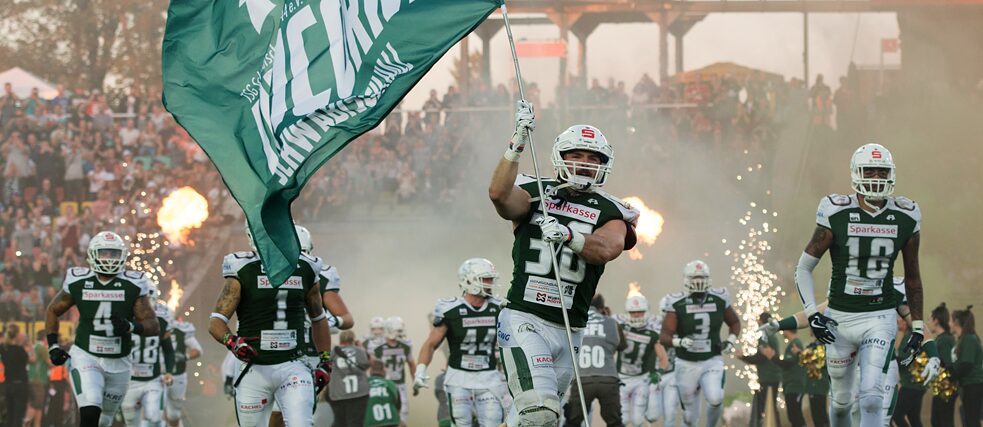 The unicorns of American Football: The "Schwäbisch Hall Unicorns" run out onto the field.
| Photo (detail): © picture alliance / Annegret Hilse / dpa
The Schwäbisch Hall Unicorns have always been pioneers in American football in Germany, and the club founded in 1983 has won a number of German championships. The Unicorns also work with at-risk youth. The popularity of this typically American sport is due to the fact that Schwäbisch Hall used to be home to a US garrison. By now though, American football is part and parcel of the city – very successfully, it has to be said.
The unicorns of American Football: The "Schwäbisch Hall Unicorns" run out onto the field.
| Photo (detail): © picture alliance / Annegret Hilse / dpa
The Schwäbisch Hall Unicorns have always been pioneers in American football in Germany, and the club founded in 1983 has won a number of German championships. The Unicorns also work with at-risk youth. The popularity of this typically American sport is due to the fact that Schwäbisch Hall used to be home to a US garrison. By now though, American football is part and parcel of the city – very successfully, it has to be said.
Raise a glass
 A place to feel at home: Hall is known for its relaxed pace of life and joie de vivre.
| Photo (detail): © Stadt Schwäbisch Hall
Hall is known for its relaxed pace of life and joie de vivre. Whenever the weather permits, the sidewalk tables of the many cafes and bars fill with celebrants enjoying life to the fullest. The many coffee houses, pubs, teashops, snack bars and even star restaurants provide plenty of space to kick back and relax. Hall might not be the best place to stick to your diet though, as the many sweet treats are an invitation to indulge, from rich sour-cream cake to the Comburg moon, a macaroon with chocolate crème. With its rich range of culture and powerful economy, Schwäbisch Hall could rightly be called the world’s smallest cosmopolitan city. And Hall, with its relaxed pace, is a city that will make you feel right at home.
A place to feel at home: Hall is known for its relaxed pace of life and joie de vivre.
| Photo (detail): © Stadt Schwäbisch Hall
Hall is known for its relaxed pace of life and joie de vivre. Whenever the weather permits, the sidewalk tables of the many cafes and bars fill with celebrants enjoying life to the fullest. The many coffee houses, pubs, teashops, snack bars and even star restaurants provide plenty of space to kick back and relax. Hall might not be the best place to stick to your diet though, as the many sweet treats are an invitation to indulge, from rich sour-cream cake to the Comburg moon, a macaroon with chocolate crème. With its rich range of culture and powerful economy, Schwäbisch Hall could rightly be called the world’s smallest cosmopolitan city. And Hall, with its relaxed pace, is a city that will make you feel right at home.
City Contours
Allotments in Berlin or skinny-dipping in Munich: come and explore some German cities with us – also against the grain. We give you an outline of the classic places, communities and events that are an intrinsic part of the city profile – and we redraw the contours by challenging a few clichés.
Comments
Comment